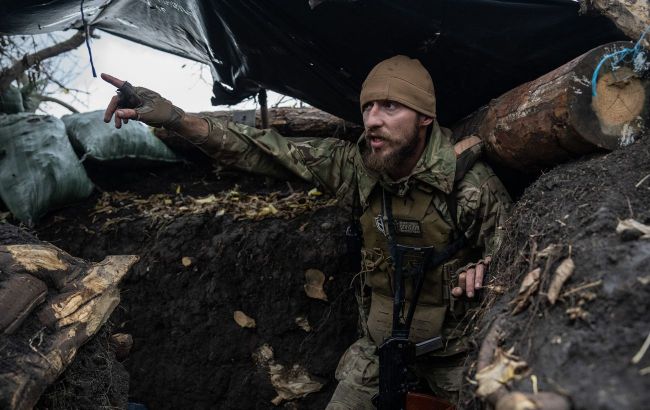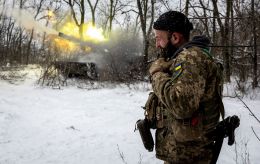As Washington talks peace, Moscow escalates. Latest from Russia-Ukraine frontlines
 Ukrainian soldier (Getty Images)
Ukrainian soldier (Getty Images)
While the US is trying to end the war and Ukraine is stating its readiness for peace negotiations, Russia has once again intensified offensive actions. What is happening at the Russia-Ukraine front now – read in the material below.
The Russian army over the past two weeks has again intensified offensive actions in various sections of the front. This activity may indicate one of the possible courses of action by Moscow.
The first – taking advantage of the uncertainty in the start of any peace negotiations, the aggressor wants to manage to seize even more territory to improve its positions.
The second – Russia is preparing for a larger-scale offensive and has already begun probing for possible weak spots in Ukrainian defense. In the end, none of these options exclude the other.
Kursk, Belgorod regions and Sumy region
Russia has managed to further compress the Ukrainian foothold in the Kursk region to approximately 50 square kilometers. The latest data from OSINT observers indicate that the enemy has already entered or even fully taken control of the settlement of Guyevo. The enemy's advance in the Kursk region opens new threats for the Defense Forces – several tens of thousands of reserves freed up after the operation there could be redirected for an offensive in some other direction.
These could be Sumy and Kharkiv regions, where Moscow intends to create a buffer zone. Occupation forces have already entered several settlements in the Sumy region – Novenke and partially Basivka. Their task is to advance further toward Yunakivka and the Sudzha checkpoint to strike at the rear of the Ukrainian grouping remaining in the Kursk region and simultaneously create that very same "sanitary zone" on their border area. However, experts claim that in Yunakivka, Novenke, and Basivka the Russians are advancing with small sabotage-reconnaissance groups – 5–7 men each.
"They entered Novenke, it is completely bombed out, there's nothing to cling to. But DRG (sabotage-reconnaissance groups) entered, 5–7 bodies each, microscopic. Their task is to launch drones, monitor troop movements. Their task is to inflict maximum damage on the logistics carried out along the road. But this does not mean they entered and entrenched themselves, we're talking about several such DRGs," said military expert Pavlo Narozhnyi in a comment to RBC-Ukraine.
The recent entry of the Defense Forces into the neighboring Belgorod region is aimed precisely at preventing the enemy from strengthening its grouping in the Sumy region or in some other section of the front, on the one hand. On the other – to tie up the occupation army on Russian territory.
Ukrainian troops entered the border Russian villages of Popovka and Demidovka, and the Russians have not been able to push them out for three weeks now. Possibly, it is precisely because of this raid that the Russians were forced to pause their plans, believes former spokesperson of the General Staff of the Armed Forces of Ukraine, Vladyslav Selezniov.
"Among the likely directions where the enemy would want to direct its resources, in particular units of the airborne forces of the Russian army – is the Dnipro direction. Either the area of the Zaporizhzhia region, or the Kherson region. I think the enemy had such plans from the beginning, but was forced to adjust them because of problems on the territory of the Belgorod region," said Selezniov in a comment to RBC-Ukraine.
Kupiansk, Lyman directions, Toretsk and Chasiv Yar
In the Kupiansk direction, the enemy army continues to gradually expand its foothold on the right bank of the Oskil River, in order to later move toward Kupiansk not only from the east but also from the north. Currently, the closest enemy positions to the city are six kilometers away. Further south, on the left bank of the Oskil, the Defense Forces achieved a tactical success near Borova – the village of Nadiia was liberated.
The situation is worse in the Lyman direction. The aggressor continues to expand its bulge there along the western bank of the Zherebets River – this is the north of the Donetsk region. Simultaneously, on the eastern bank, it has already entered Yampolivka – a settlement that the Ukrainian army had regained control of during the fall counteroffensive in 2022.
Both the Kupiansk and Lyman directions, along with Siversk, Chasiv Yar, and Toretsk – are necessary elements for the enemy's further offensive on the Sloviansk-Kramatorsk agglomeration. So far, in the Siversk area, the enemy is not showing much activity. In Chasiv Yar, fighting is still ongoing – Ukrainian units have managed to hold their positions within the city for almost a year now.

Ukrainian troops in March 2025 in the Donetsk direction (photo: Getty Images)
In Toretsk, the situation has started to worsen in recent weeks. The battle for this city has also been ongoing for 9 months. The enemy has pushed the Defense Forces from the central part of the city to the outskirts and has intensified pressure on surrounding settlements. According to Selezniov, the loss of control over Toretsk would mean a serious deterioration of the situation in the Chasiv Yar area. This way, Russian troops could form a convenient foothold for an attack toward Kostiantynivka.
"And Kostiantynivka is part of the large urban agglomeration 'Sloviansk-Kramatorsk-Druzhkivka and Kostiantynivka.' That is, we can say that we will soon have a Kostiantynivka direction and battles there. Because the enemy will focus its efforts during the spring-summer campaign precisely on this urban agglomeration," forecasts Selezniov.
Pokrovsk and Zaporizhzhia
A series of successful counterattacks near Pokrovsk, carried out by Ukrainian troops, managed to slow the enemy’s advance toward the city. However, in recent weeks the enemy has increased the number of assaults in this direction and managed to regain some previously lost positions, particularly in the area of Shevchenko and Udachne. In addition, they have once again become active near Vozdvyzhenka – on the other flank of the Pokrovsk direction. Despite all the pessimistic forecasts about the imminent fall of Pokrovsk circulating earlier in the media, battles directly in the city no longer seem like such an imminent prospect.
Despite the fact that the enemy has brought in additional forces and equipment to this direction and is gradually gaining control of meters of territory, it all looks more like a tactical advance. In some areas, the Defense Forces are advancing, in others – the Russians.
"The advance is minor. If we look at the General Staff's report, the dynamics of the Russian army's advance at the end of March and beginning of April has significantly decreased. The level of Russian losses is not decreasing in fact – over a thousand killed and wounded Russian servicemen per day – but the territories gained are significantly fewer than they were a month or two ago," says Selezniov.
Further south, the enemy is still attempting, with two “columns” – from Velyka Novosilka from the south and Ulakly from the east – to reach the Donetsk-Zaporizhzhia road. On the eastern section the main fighting is currently for the settlement of Kostiantynopil, from which, most likely, the Defense Forces will soon have to withdraw to the Oleksiivka–Bohatyr line. On the southern – the Russians are pressing on settlements along the Mokri Yaly River from Dniproenerhiia and Burlatske. This latter section is particularly dangerous as it brings combat operations closer to the Dnipropetrovsk region.
In the neighboring Zaporizhzhia region, the Russians have also begun offensive actions. Two areas are now emerging where the enemy is pushing – toward Shcherbaky and Stepove. The immediate task for them here is to reach the Kamianske–Orikhiv road. It is hardly a “large offensive on Zaporizhzhia,” but the enemy, in the case of further successes, will attempt to scale up offensive actions here. And their goal may be either to seize Orikhiv or to move toward Zaporizhzhia.
However, the goal of the Russian army is not entirely clear. To occupy Zaporizhzhia, as with any other large city, the Russian army clearly lacks the resources. Moreover, it would be illogical to leave Donbas, parts of which are still held by Ukrainian troops, in the rear. A more logical plan looks to be the probable attempt to cut off the road through Pokrovsk, which serves as the main logistics route for the Armed Forces of Ukraine.
"It’s easier for them to cut the road through Pokrovsk, and Donbas will fall. If Donbas falls, their logistics will improve significantly," adds Narozhnyi.
As for the Kherson direction, the situation remains unchanged. Russian troops are trying to consolidate on the islands, but it’s impossible to fortify there. They quickly become targets for Ukrainian artillerymen.

